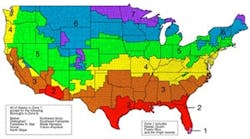BUILDINGS readers are probably aware of the recent changes to ASHRAE’s 90.1-2010 standard, which has long served as the model for U.S. energy codes.
For the U.S., ASHRAE has prescribed eight climate zones. For low-slope commercial roof systems, roofs in Zone 1 (the warmest climate) have required a minimum R-value of 15, and the remaining seven zones call for R=20. The proposed changes would require progressively greater amounts of thermal insulation in each zone (see below). Not all proposed changes are accepted, however, so stay tuned.
| ASHRAE’S Proposed New Insulation Requirements | |||||
|
Climate Zone |
Insulation Entirely Above Deck |
Metal Roofs (liner below purlins or uncompressed, unfaced insulation draped between purlins) |
Attic and Other |
||
|
Zones 1-3 |
R=20 |
|
|
||
|
Zones 4-5 |
R=25 |
|
|
||
|
Zone 6 |
R=30 |
|
|
||
|
Zones 7-8 |
R=35 |
|
|
||
|
Zones 1-5 |
|
R=19 + R=11 |
|
||
|
Zone 6 |
|
R=25 + R=11 |
|
||
|
Zone 7-8 |
|
R=30 + R=11 |
|
||
|
Zones 1-5 |
|
|
R=38 |
||
|
Zones 6-8 |
|
|
R=49 |
||
Published resistances (R-values) for construction materials can be found in the ASHRAE Handbook of Fundamentals and in material manufacturers’ literature. Note that different resources may provide different values. The Manual of Low Slope Roofing offers these R-values per inch of thickness for several common roofing materials:
Cellular glass (Foamglas): 2.6
Wood fiber: 2.8
Perlite board: 2.8
Molded polystyrene: 3.8
Glass fiber: 4.2
Basalt wool: 4.2
Extruded polystyrene: 5.0
Polyisocyanurate foam: 6.2
If the proposed changes above are adopted by ASHRAE and work their way into the International Building Code (IBC), the required minimum thickness of thermal insulation for each climate zone would look more like this:
Minimum Insulation Thickness by Material
|
|
Material |
||||
|
R-Value |
Wood fiber or perlite |
Molded polystyrene |
Glass or basalt fiber |
Extruded polystyrene |
Polyisocyanurate foam |
|
R=20 |
7.2 |
5.2 |
4.8 |
4 |
3.2 |
|
R=25 |
9 |
6.6 |
5.9 |
5 |
4 |
|
R=30 |
10.7 |
7.9 |
7.1 |
6 |
4.8 |
|
R=35 |
12.6 |
9.2 |
8.3 |
7 |
5.6 |
How Did We Get Here?
Prior to World War II, many buildings had either concrete or heavy timber roof decks. Because of the thermal mass and relatively low cost of energy, these buildings frequently did not use any thermal insulation at all. After the war, steel, plywood, OSB, gypsum, insulating concrete, and other lightweight roof decks came into vogue. To span the ribs of a steel deck, a leveling course of ¾ inch to 1 inch of roof insulation was used. Wood fiber, perlite board, and glass fiber board were used. From a thermal insulation point of view, these products added an R-value of about 3 per inch of thickness.
After the oil embargo of 1973-1974, the price of energy surged, making thermal insulation an important design consideration. Polyurethane roof insulation with an R of 5.5-6 per inch and polystyrene insulation with an R of 4-5 per inch began to displace less efficient materials. These foam insulations could not meet the under-deck fire resistance requirements of FM, so combination boards filled this gap, using perlite on the deck side as a fire barrier and placing the foam above.
Eventually, improvements in the chemistry of polyurethane foam (polyisocyanurate foam or isoboards) resulted in products that could meet the Class 1 FM requirements without the need for an underlayment. Separate layers of gypsum board also met fire requirements, qualifying both Isoboards and polystyrene insulations. Current building codes require R=15 for Zone 1 and R=20 for Zones 2-8. This translates to a thickness of about 2.67 inches for isoboard in Zone 1 and 3.5 inches in Zones 2-8. (For perlite or wood fiber, that would require over 7 inches of material!)
The Hidden Costs of Insulation Regulations
Imposing mandatory requirements for thermal insulation fails to account for the incremental cost of added insulation. Not only does the cost of insulation rise in a straight line with thickness, but the curve illustrating the reduction in heat flow flattens, meaning that the savings in energy diminishes at greater thickness. The cost is also affected by the volume of roofing material shipped, site storage, hoisting, and application. Not to mention the greater volume of material that heads to landfills or recycling facilities at the end of its service life.
Other issues with insulation requirements include:
- Incremental cost of wood blocking at perimeters and curbs to match the thickness of the thermal insulation.
- Incremental cost of metal edging to cover the blocking and serve as fascia or drip edge.
- The potential that mechanical units and curbs may need to be raised when reroofing flashings, resulting in significant costs that far exceed the energy savings.
- A need to upgrade roof membranes to achieve better puncture resistance and durability to protect the investment in thermal insulation.
What Do the Numbers Tell Us?
Imagine these new requirements are adopted by the IBC. If we needed an R-value of 25 for our climate zone, for example, we could decide not to put all the insulation above the deck and instead use 2 inches of extruded, ballasted polystyrene foam over the primary membrane in a PMR configuration and account for the remaining R=15 with our choice of insulation between the deck and membrane.
Above, note the difference between a PMR system and the conventional alignment of components. This is followed by an example of a lightweight PMR system using a composite paver of latex-modified cement and extruded polystyrene with added metal strapping in the perimeter for enhanced wind uplift resistance.
This approach protects the roof membrane against hail, physical abuse, and extreme thermal swings, enhancing sustainability. Not only that, but the ballast and thermal insulation are both reusable. This way, the next time ASHRAE and IBC upgrade their thermal requirements, we could just lift the ballast, add more extruded polystyrene foam, and put everything back together again.
Richard (Dick) L. Fricklas was technical director emeritus of the Roofing Industry Educational Institute prior to his retirement. He is co-author of The Manual of Low Slope Roofing Systems and continues to participate in seminars for the University of Wisconsin and RCI Inc., the Institute of Roofing, Waterproofing, and Building Envelope Professionals. His honors include the William C. Cullen Award and Walter C. Voss Award from ASTM, the J. A. Piper Award from NRCA, the William C. Correll award from RCI, and the James Q. McCawley Award from the MRCA. Dick holds honorary memberships in both ASTM and RCI Inc.
Roof Insulation and Diminishing Returns
The impact of ASHRAE Standard 90.1 on the roofing industry.
Insulation: EPS vs. XPS
Comparing popular polystyrene insulation.
Keep Your Insulation Dry
Prevent wet insulation to protect building integrity, efficiency, and occupant health.


